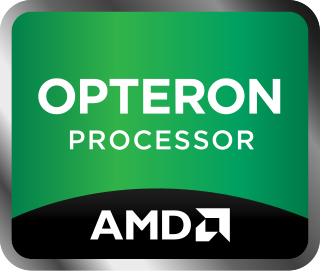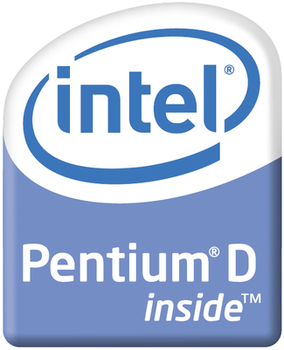The thermal design power (TDP), sometimes called thermal design point, is the maximum amount of heat generated by a computer chip or component (often a CPU, GPU or system on a chip) that the cooling system in a computer is designed to dissipate under any workload.
Some sources state that the peak power rating for a microprocessor is usually 1.5 times the TDP rating. [1]
Intel has introduced a new metric called scenario design power (SDP) for some Ivy Bridge Y-series processors. [2] [3]
| ACP | TDP |
|---|---|
| 40 W | 60 W |
| 55 W | 79 W |
| 75 W | 115 W |
| 105 W | 137 W |
The average CPU power (ACP) is the power consumption of central processing units, especially server processors, under "average" daily usage as defined by Advanced Micro Devices (AMD) for use in its line of processors based on the K10 microarchitecture (Opteron 8300 and 2300 series processors). Intel's thermal design power (TDP), used for Pentium and Core 2 processors, measures the energy consumption under high workload; it is numerically somewhat higher than the "average" ACP rating of the same processor.
According to AMD the ACP rating includes the power consumption when running several benchmarks, including TPC-C, SPECcpu2006, SPECjbb2005 and STREAM Benchmark [5] (memory bandwidth), [6] [7] [8] which AMD said is an appropriate method of power consumption measurement for data centers and server-intensive workload environments. AMD said that the ACP and TDP values of the processors will both be stated and do not replace one another. Barcelona and later server processors have the two power figures.
The TDP of a CPU has been underestimated in some cases, leading to certain real applications (typically strenuous, such as video encoding or games) causing the CPU to exceed its specified TDP and resulting in overloading the computer's cooling system. In this case, CPUs either cause a system failure (a "therm-trip") or throttle their speed down. [9] Most modern processors will cause a therm-trip only upon a catastrophic cooling failure, such as a no longer operational fan or an incorrectly mounted heat sink.
For example, a laptop's CPU cooling system may be designed for a 20 W TDP, which means that it can dissipate up to 20 watts of heat without exceeding the maximum junction temperature for the laptop's CPU. A cooling system can do this using an active cooling method (e.g. conduction coupled with forced convection) such as a heat sink with a fan, or any of the two passive cooling methods: thermal radiation or conduction. Typically, a combination of these methods is used.
Since safety margins and the definition of what constitutes a real application vary among manufacturers, TDP values between different manufacturers cannot be accurately compared (a processor with a TDP of, for example, 100 W will almost certainly use more power at full load than processors with a fraction of said TDP, and very probably more than processors with lower TDP from the same manufacturer, but it may or may not use more power than a processor from a different manufacturer with a not excessively lower TDP, such as 90 W). Additionally, TDPs are often specified for families of processors, with the low-end models usually using significantly less power than those at the high end of the family.
Until around 2006 AMD used to report the maximum power draw of its processors as TDP. Intel changed this practice with the introduction of its Conroe family of processors. [10] Intel calculates a specified chip's TDP according to the amount of power the computer's fan and heatsink need to be able to dissipate while the chip is under sustained load. Actual power usage can be higher or (much) lower than TDP, but the figure is intended to give guidance to engineers designing cooling solutions for their products. [11] In particular, Intel's measurement also does not fully take into account Intel Turbo Boost due to the default time limits, while AMD does because AMD Turbo Core always tries to push for the maximum power. [12]
TDP specifications for some processors may allow them to work under multiple different power levels, depending on the usage scenario, available cooling capacities and desired power consumption. Technologies that provide such variable TDPs include Intel's configurable TDP (cTDP) and scenario design power (SDP), and AMD's TDP power cap.
Configurable TDP (cTDP), also known as programmable TDP or TDP power cap, is an operating mode of later generations of Intel mobile processors (as of January 2014 [update] ) and AMD processors (as of June 2012 [update] ) that allows adjustments in their TDP values. By modifying the processor behavior and its performance levels, power consumption of a processor can be changed altering its TDP at the same time. That way, a processor can operate at higher or lower performance levels, depending on the available cooling capacities and desired power consumption. [13] : 69–72 [14] [15]
Intel processors that support cTDP provide three operating modes: [13] : 71–72
For example, some of the mobile Haswell processors support cTDP up, cTDP down, or both modes. [16] As another example, some of the AMD Opteron processors and Kaveri APUs can be configured for lower TDP values. [15] IBM's POWER8 processor implements a similar power capping functionality through its embedded on-chip controller (OCC). [17]
Intel's description of scenario design power (SDP): "SDP is an additional thermal reference point meant to represent thermally relevant device usage in real-world environmental scenarios. It balances performance and power requirements across system workloads to represent real-world power usage." [18]
Scenario design power (SDP) is not an additional power state of a processor. The SDP only states the average power consumption of a processor using a certain mix of benchmark programs to simulate "real-world" scenarios". [2] [19] [20] For example, Y-series (extreme-low power) mobile Haswell processor show the difference between TDP and SDP. [18]

Pentium 4 is a series of single-core CPUs for desktops, laptops and entry-level servers manufactured by Intel. The processors were shipped from November 20, 2000 until August 8, 2008. It was removed from the official price lists starting in 2010, being replaced by Pentium Dual-Core.

Opteron is AMD's x86 former server and workstation processor line, and was the first processor which supported the AMD64 instruction set architecture. It was released on April 22, 2003, with the SledgeHammer core (K8) and was intended to compete in the server and workstation markets, particularly in the same segment as the Intel Xeon processor. Processors based on the AMD K10 microarchitecture were announced on September 10, 2007, featuring a new quad-core configuration. The last released Opteron CPUs are the Piledriver-based Opteron 4300 and 6300 series processors, codenamed "Seoul" and "Abu Dhabi" respectively.

In computing, overclocking is the practice of increasing the clock rate of a computer to exceed that certified by the manufacturer. Commonly, operating voltage is also increased to maintain a component's operational stability at accelerated speeds. Semiconductor devices operated at higher frequencies and voltages increase power consumption and heat. An overclocked device may be unreliable or fail completely if the additional heat load is not removed or power delivery components cannot meet increased power demands. Many device warranties state that overclocking or over-specification voids any warranty, but some manufacturers allow overclocking as long as it is done (relatively) safely.

The Athlon 64 is a ninth-generation, AMD64-architecture microprocessor produced by Advanced Micro Devices (AMD), released on September 23, 2003. It is the third processor to bear the name Athlon, and the immediate successor to the Athlon XP. The Athlon 64 was the second processor to implement the AMD64 architecture and the first 64-bit processor targeted at the average consumer. Variants of the Athlon 64 have been produced for Socket 754, Socket 939, Socket 940, and Socket AM2. It was AMD's primary consumer CPU, and primarily competed with Intel's Pentium 4, especially the Prescott and Cedar Mill core revisions.
Processor power dissipation or processing unit power dissipation is the process in which computer processors consume electrical energy, and dissipate this energy in the form of heat due to the resistance in the electronic circuits.

Pentium D is a range of desktop 64-bit x86-64 processors based on the NetBurst microarchitecture, which is the dual-core variant of the Pentium 4 manufactured by Intel. Each CPU comprised two cores. The brand's first processor, codenamed Smithfield and manufactured on the 90 nm process, was released on May 25, 2005, followed by the 65 nm Presler nine months later. The core implementation on the 90 nm "Smithfield" and later 65 nm "Presler" are designed differently but are functionally the same. The 90 nm "Smithfield" contains a single die, with two adjoined but functionally separate CPU cores cut from the same wafer. The later 65 nm "Presler" utilized a multi-chip module package, where two discrete dies each containing a single core reside on the CPU substrate. Neither the 90nm "Smithfield" nor the 65 nm "Presler" were capable of direct core to core communication, relying instead on the northbridge link to send information between the 2 cores.
AMD Cool'n'Quiet is a CPU dynamic frequency scaling and power saving technology introduced by AMD with its Athlon XP processor line. It works by reducing the processor's clock rate and voltage when the processor is idle. The aim of this technology is to reduce overall power consumption and lower heat generation, allowing for slower cooling fan operation. The objectives of cooler and quieter result in the name Cool'n'Quiet. The technology is similar to Intel's SpeedStep and AMD's own PowerNow!, which were developed with the aim of increasing laptop battery life by reducing power consumption.
In the fields of digital electronics and computer hardware, multi-channel memory architecture is a technology that increases the data transfer rate between the DRAM memory and the memory controller by adding more channels of communication between them. Theoretically, this multiplies the data rate by exactly the number of channels present. Dual-channel memory employs two channels. The technique goes back as far as the 1960s having been used in IBM System/360 Model 91 and in CDC 6600.
The AMD Family 10h, or K10, is a microprocessor microarchitecture by AMD based on the K8 microarchitecture. The first third-generation Opteron products for servers were launched on September 10, 2007, with the Phenom processors for desktops following and launching on November 11, 2007 as the immediate successors to the K8 series of processors.

AMD Accelerated Processing Unit (APU), formerly known as Fusion, is a series of 64-bit microprocessors from Advanced Micro Devices (AMD), combining a general-purpose AMD64 central processing unit (CPU) and 3D integrated graphics processing unit (IGPU) on a single die.
AMD Turion is the brand name AMD applies to its x86-64 low-power consumption (mobile) processors codenamed K8L. The Turion 64 and Turion 64 X2/Ultra processors compete with Intel's mobile processors, initially the Pentium M and the Intel Core and Intel Core 2 processors.
The AMD Bulldozer Family 15h is a microprocessor microarchitecture for the FX and Opteron line of processors, developed by AMD for the desktop and server markets. Bulldozer is the codename for this family of microarchitectures. It was released on October 12, 2011, as the successor to the K10 microarchitecture.

Phenom II is a family of AMD's multi-core 45 nm processors using the AMD K10 microarchitecture, succeeding the original Phenom. Advanced Micro Devices released the Socket AM2+ version of Phenom II in December 2008, while Socket AM3 versions with DDR3 support, along with an initial batch of triple- and quad-core processors were released on February 9, 2009. Dual-processor systems require Socket F+ for the Quad FX platform. The next-generation Phenom II X6 was released on April 27, 2010.
Intel Turbo Boost is Intel's trade name for central processing units (CPUs) dynamic frequency scaling feature that automatically raises certain versions of its operating frequency when demanding tasks are running, thus enabling a higher resulting performance.

Broadwell is the fifth generation of the Intel Core processor. It is Intel's codename for the 14 nanometer die shrink of its Haswell microarchitecture. It is a "tick" in Intel's tick–tock principle as the next step in semiconductor fabrication. Like some of the previous tick-tock iterations, Broadwell did not completely replace the full range of CPUs from the previous microarchitecture (Haswell), as there were no low-end desktop CPUs based on Broadwell.
AMD Piledriver Family 15h is a microarchitecture developed by AMD as the second-generation successor to Bulldozer. It targets desktop, mobile and server markets. It is used for the AMD Accelerated Processing Unit, AMD FX, and the Opteron line of processors.

Kaby Lake is Intel's codename for its seventh generation Core microprocessor family announced on August 30, 2016. Like the preceding Skylake, Kaby Lake is produced using a 14 nanometer manufacturing process technology. Breaking with Intel's previous "tick–tock" manufacturing and design model, Kaby Lake represents the optimized step of the newer process–architecture–optimization model. Kaby Lake began shipping to manufacturers and OEMs in the second quarter of 2016, with its desktop chips officially launched in January 2017.
AMD Turbo Core a.k.a. AMD Core Performance Boost (CPB) is a dynamic frequency scaling technology implemented by AMD that allows the processor to dynamically adjust and control the processor operating frequency in certain versions of its processors which allows for increased performance when needed while maintaining lower power and thermal parameters during normal operation. AMD Turbo Core technology has been implemented beginning with the Phenom II X6 microprocessors based on the AMD K10 microarchitecture. AMD Turbo Core is available with some AMD A-Series accelerated processing units.